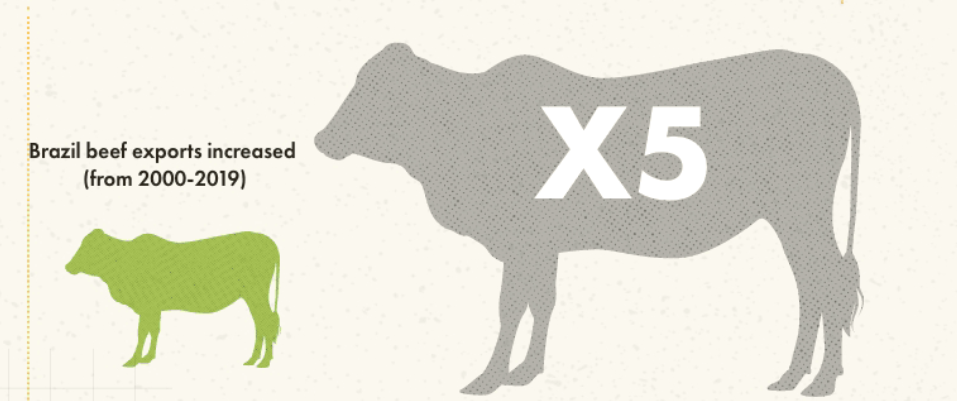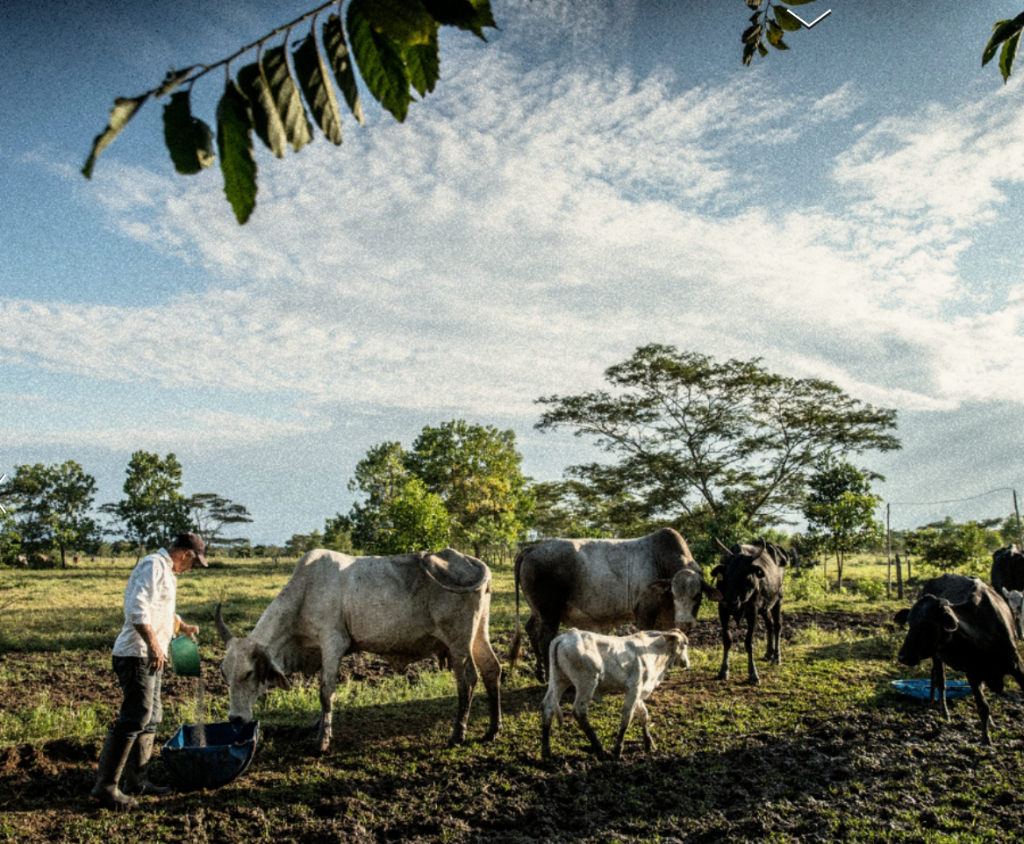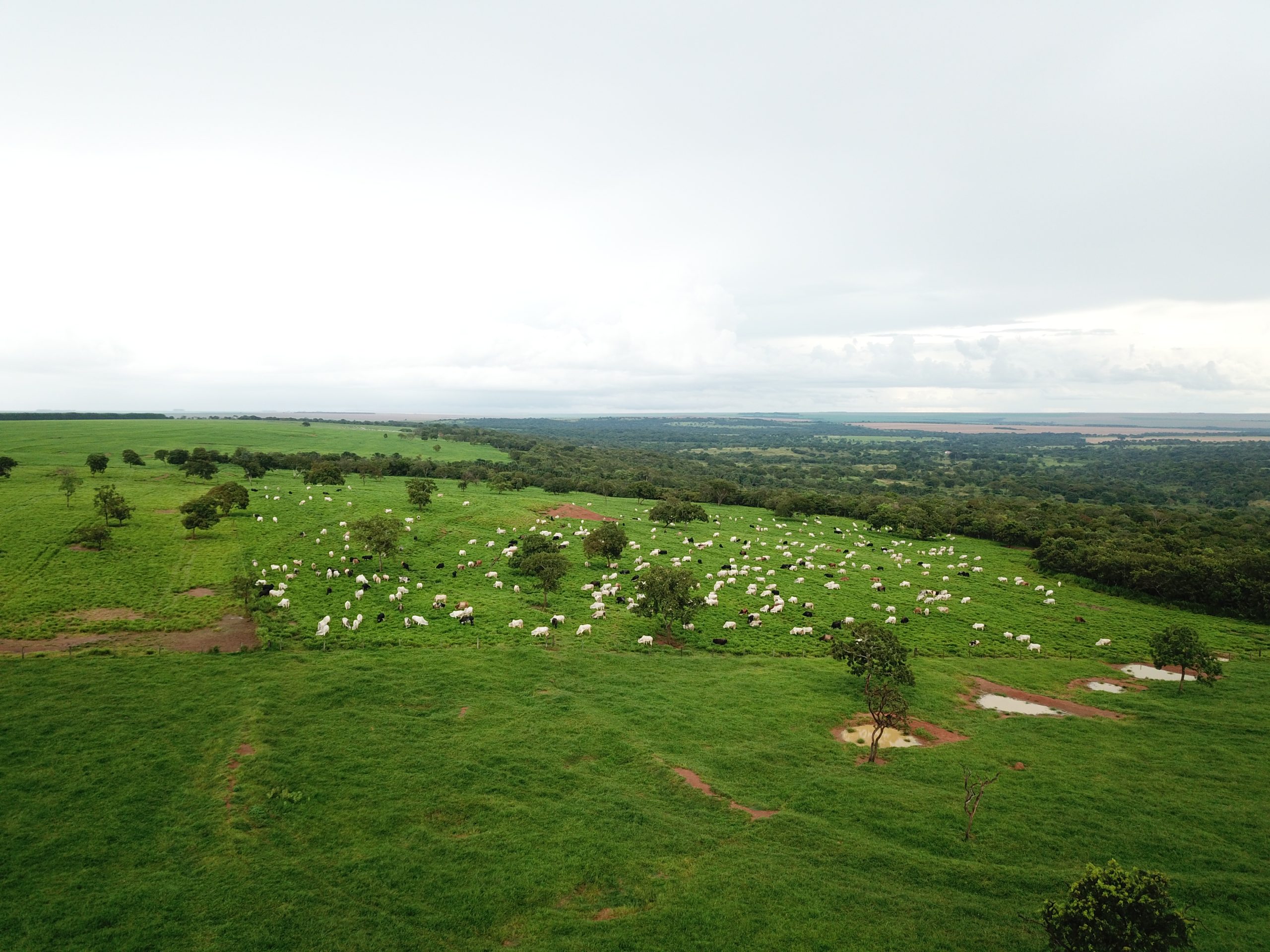This article was originally posted in TFA Perspectives here.
Cattle ranching is the big beast devouring Brazil’s forests. Beef is responsible for an estimated 93% of deforestation in the Amazon and 70% in the Cerrado, the world’s most biodiverse savanna that lies to the south of the Amazon. Pasture deforestation claimed an estimated 1.1 million hectares of tree cover in these two biomes alone in 2018, according to Trase, a supply-chain tracking initiative which has calculated that the deforestation hoofprint of Brazil’s beef exports is 1,000 times greater than that of its chicken exports.

Despite a deafening stampede of grim statistics on beef’s impact on the environment, however, only a small minority of consumers have actually changed their meat intake for ecological reasons, according to a recent meta-analysis of global meat consumption. While Brazilians themselves consume three-quarters of what they produce, the global appetite for beef continues to grow – especially in China.
Brazil’s beef exports increased five-fold from 2000-2019, and demand for the commodity is expected to increase by around 35% over the next two decades. So if demand for beef doesn’t drop, how can farmers make the supply more sustainable? Can beef – so long the wasteful, prodigal son – reform its ways? Solving Brazil’s cattle conundrum is a complex systemic challenge that we can’t do justice to in this short article. At the heart of the issue are the failure of markets to attribute sufficient value to standing forests and the failure of governments to combat illegal deforestation by land speculators. And at the root of both these failures lies an economic model that rewards destruction of forests rather than sustainable farming and forest protection. There are many solutions to these challenges, but in this article we are focusing on one of the most vital – productivity.
Healthy animals and pastures are critical to combat deforestation
Improving the productivity of Brazil’s beef industry is vital, if the country is to keep pace with growing demand and provide incomes for its farmers, while reversing the catastrophic clearance of forests for pasture. Put simply: the more meat you can produce per hectare, the less land you need. And the faster you can fatten up your livestock for slaughter, the less time they spend belching methane, a greenhouse gas that has 80 times more warming power than carbon dioxide over the first 20 years it spends in the atmosphere.
Productivity is driven by many factors, but at its core lie improvements in the health of pasture and animals, along with more efficient management. Today, the Brazilian Amazon has 56.6 million hectares of cultivated pasture, but 53% of this is classified as degraded, according to the Brazilian mapping initiative MapBiomas. Degraded pastureland cannot support as many animals as healthy land, so the number of animals per hectare in Brazil is often far lower than it could be. In the Argentinian Chaco biome, for example, it’s about one animal per 3-5 hectares, while in the Brazilian Amazon it’s less than one animal per hectare, according to Javier Ortiz, Regional Director of Latin America for the Tropical Forest Alliance.
We don’t need to increase the area under pasture in the Amazon Chaco or Cerrado to produce more beef, milk, leather or other cattle products when we can farm more sustainably and intensively
Javier Ortiz, Regional Director of Latin America, Tropical Forest Alliance
The land already cleared in Brazil for agriculture is already more than sufficient to support a growing demand for both beef and soy. The priority is to improve the productivity of degraded pastureland, rather than destroying forests to create new pastures. “We don’t need to increase the area under pasture in the Amazon, Chaco or Cerrado to produce more beef, milk, leather or other cattle products when we can farm more sustainably and intensively”, says Ortiz.
On the livestock side, explains Ortiz, a more intensive approach could double the number of animals per hectare, reduce the time taken to gain weight, increase birth rates and other productivity indicators.
On the pasture side, a more sustainable approach to farming includes dividing plots to ensure adequate rotation of pastures, introducing trees and improving the genetic strength of the herd. “The level of investment has a direct impact on the level of productivity”, says Ortiz, who adds: “Simply dividing plots and managing pastures can double production, while intensive silvopasture systems can increase productivity up to seven times.”
Agroforestry improves soil and animal health while capturing more carbon
Agroforestry and silvopasture improve the health of both soils and animals (see box). And, as well as reducing the need to clear more forest, these approaches increase the land’s resilience to climate change and enhance its capacity as a carbon sink. Agroforestry approaches that incorporate cattle pastures with forests and products such as cocoa and rubber can capture around 60 tonnes of carbon dioxide per hectare, according to Leandro Baumgarten, zero deforestation strategy scientist at The Nature Conservancy.
Benefits of agroforesty and silvopasture
Agroforestry is defined as the deliberate integration of trees with crops and/or livestock, either simultaneously or sequentially on the same unit of land. Silvopasture is a category of agroforestry in which trees are integrated with grazing animals to create a managed woodland pasture. There are two ways to achieve a silvopasture, either by planting trees in a pasture or by thinning a forest enough to establish pasture plants. The aim is to have enough trees to secure the benefits that trees bring but to manage them, so they do not over-shade the pasture. In typical silvopasture systems, the trees are productive; either producing and timber crop or a fruit or nut harvest.
But the real benefits are the improvements in soil health and animal welfare. Improved animal health is a significant benefit of silvopasture. Shelter, shade and access to browse are the three main advantages; all three help improve animal growth rates. The micro-climate under an open canopy of trees, especially when intersected with denser shelterbelts or hedges, is much less variable as it buffers against extreme weather events. If an animal has to expend less energy maintaining their core body temperature, that energy goes into weight gain, ensuring better welfare and profit.
So why isn’t this already happening? Lack of investment and technical capacity, failure in law enforcement, poor market infrastructure and a fragmented cattle farming sector are some of the factors. Ninety per cent of Brazil’s beef farming is generated by low-tech ranching operations that invest little in managing the health of their soils or animals. The result is pastureland, especially in the vulnerable soils of the Amazon, that can lose its capacity to feed animals within three or four years, fuelling an unstoppable demand for more forest clearance to expand production. The hunger for land in turn fuels illegal land grabbing by criminals who use low-tech cattle ranching as a cheap way to occupy and clear forest land, which they sell on in the future at hugely inflated profits.

Money matters – farmers who avoid deforestation and embrace sustainability need to see the benefit
Perspectives interviewed André Guimarães, executive director of IPAM (the Amazon Environmental Research Institute), which works with smallholders to prove that – with technical assistance, credit and better infrastructure – they can produce more and deforest less. He points out some of the co-benefits of agroforestry. By combining cattle with crops such as cocoa and manioch, smallholders can boost their savings, cashflow and nutrition. “Cattle function like a savings account, while agroforestry crops act as their current account,” he says.
Making sustainable beef production work economically for farmers is vital, but it’s not happening fast enough. “The farmers today still don’t see the value proposition – their first question is, ‘How much more am I getting out of this?’”, said Mattias Almeida, CEO of Nat Cap, Brazil, in a recent session at New York Climate Week. Nat Cap is working with farmers in Mato Grosso, Brazil’s third largest state, to improve the sustainable production of calves. “We’re trying to get a premium on the calf”, said Almeida, “but in the end we need to deliver cheaper credit for the farmer and cheaper inputs for production to improve.” It’s really important to find a way of bringing economic benefit to the farmers who are trying to become more sustainable and who are avoiding deforestation, instead of just telling them to abide by the Forest Code, added Almeida. “With this support we’ll be able to make sure these guys keep producing in an efficient way and be part of the emissions reduction programmes of companies as well”, he said.
We’re paying farmers to give up their right to deforest
André Guimarães
Another approach is simply to pay farmers not to deforest their land. IPAM is piloting an initiative called CONSERV, a financial compensation scheme for maintaining forest that could otherwise be legally deforested (an approach known as “payment for environmental services” or PES). “We’re paying farmers to give up their right to deforest,” says André Guimarães. Mato Grosso has over 7 million hectares of privately owned areas that could legally be deforested. CONSERV’s approach is to contract farmers for a three to four year period to incentivize them not to.
“So far so good – 100% of properties have forests still standing,” says Guimarães, adding: “We monitor the forests through satellite images and on the ground teams with drones every three months.” IPAM has developed an algorithm to calculate the value of each property based on environmental variables – typically between $45 and $70 per hectare per year. “They were happy with that number when we contracted them two years ago, but now the price of soy has doubled, they’re not so happy”, he adds.
For a country like Brazil, scale matters. In our final section, we look at a collection of projects supported by the government of Mato Grosso, including those mentioned above, to show what’s possible at a larger, landscape level.
We’re trying to get a premium on the calf, but in the end we need to deliver cheaper credit for the farmer and cheaper inputs for production to improve
Mattias Almeida, CEO, NAT CAP, Brazil
Mato Grosso – a landscape wide approach to sustainable beef farming
Brazil’s Mato Grosso state is the size of France and Germany combined and hosts the country’s largest herd of cattle, 32 million strong. The state government has taken a proactive approach to eliminating deforestation by boosting productivity in beef and soy farming. Its strategy – initiated in 2015 and known as Produce, Conserve, Include (PCI) – has big ambitions. The long list of targets to hit by 2030 includes reducing deforestation of the Amazon and Cerrado woodlands within its borders by 90-95%, eliminating illegal deforestation, recovering 2.5 million hectares of low-productivity pasture, and increasing the productivity of soy and cattle.
The PCI strategy’s approach is to support the state’s 104,000 small-scale farmers with technical assistance, finance and help to regularize their land tenure. The PCI Institute, which oversees the strategy, estimates the climate benefits of its approach could total over 6 gigatons of avoided emissions by 2030, while increasing agricultural GDP by 5 billion reals (a little under $1 billion).
Funding such ambition doesn’t come cheap. From 2016 to 2020, the programme raised $3.2 billion from 135 government-funded projects and actions (including rural credit), according to a March 2022 report by CDP, the non-profit that helps companies and cities disclose their environmental impacts. For the 2020-2030 period, CDP estimates a further $30 billion would be required to fully finance the PCI strategy, of which 80% would have to come from the private sector.
The leadership of subnational governments in conjunction with commitments from the private sector is key to fighting deforestation… Mato Grosso is a real example of a bottom-up successful jurisdictional approach
CDP
Success factors in shifting commodity-driven deforestation
What marks out the PCI Institute is that it takes a landscape, state-wide approach to tackling deforestation. This so-called “jurisdictional” approach is explored further in a recent report published by the World Economic Forum. CDP concludes, “it is undeniable that the leadership of subnational governments in conjunction with commitments from the private sector is key to fighting deforestation,” adding: “Mato Grosso is a real example of a bottom-up successful jurisdictional approach.”
What emerges from the Mato Grosso experience is that eliminating deforestation from supply chains such as beef production cannot be achieved by a single organization and cannot happen in isolation from many other factors outside the farm gate. Improving the productivity of beef ranching in Brazil could ultimately make a major contribution to reversing forest conversion. But getting to that point is highly complex and requires long-term collaboration between the public sector, private sector and civil society – along with the right technical assistance, market-based incentives and law enforcement. The PCI initiative is a state-wide, bottom-up approach whose achievements and ambition give us all something to chew over.
CDP identifies four success factors in PCI’s approach:
- Decetralized governance structure – e.g. the PCI Institute – to safeguard the continuity of the programme’s goals from political changes
- Multiple funding streams – from both public sector (e.g. international cooperation) and private sector (e.g. blended finance)
- Multi-stakeholder dialogue – engaging the government, producers and traders to work together towards government targets and deforestation-free supply chains
- Transparent tracking and disclosure – to ensure that progress towards collective goals is seen as credible
Three projects in Mato Grosso’s Amazon and Cerrado biomes aim to scale up sustainable beef farming
The Mato Grosso government is aiming to double cattle productivity from 57kg to 116kg per hectare per year by 2030. Productivity is calculated as the ratio between the total weight of slaughtered cattle and the grassland area on which it is produced, in a given year. Below, we outline three of the many programmes underway in the state.
Cerrado: Carrefour Foundation
This programme aims to transform the calf supply chain in northern Mato Grosso, by working with 457 smallholder calf producers across 256,000 hectares of farmland to supply sustainable beef to French multinational grocery retailer Carrefour. The programme has the potential to protect and restore more than 151,000 hectares of tropical forest. It is funded with EUR 2.5 million of investment by IDH Sustainable Trade Initiative and the Carrefour Foundation.
Activities include: intensifying cattle ranching by providing smallholders with technical assistance and access to credit; restoring degraded pastureland through support for smallholders with land tenure and compliance with the Brazilian Forest Code; and promoting strong market connections to accelerate economic development in the area.
Amazon: Pesca
Pecsa is an agricultural management and partnership company, based in the town of Alta Floresta, that takes over cattle ranches on severely degraded pastures in the Amazon and intensifies production through investing in the latest technologies to improve the health of its soils and livestock. The company secured a seven-year funding contract with Althelia Climate Fund to restore 10,000 hectares of degraded pastures, sustainably manage 34,000 head of cattle and restore 700 hectares of riparian forest. Its goal is to produce zero-deforestation beef after a July 2008 cut-off date.
By 2020, Pecsa had achieved a cattle density of five animals per hectare on its farms, compared to one per hectare previously. It had increased productivity by almost 10 times compared with the region’s average on degraded lands. A study by the NGO Imaflora showed that Pecsa-produced meat uses 84% less land and emits 85% fewer greenhouse gases than the baseline.
Cerrado: Araguaia League
The league is a movement of 63 farms comprising 150,000 hectares of pasture dedicated to promoting sustainable intensification, environmental compliance with the Forest Code and carbon emissions monitoring. The league is driving market development through a partnership with JBS and Imaflora, and is working with Embrapa (the state-owned Brazilian Agricultural Research Corporation) to develop a low-carbon beef project.
The Araguaia League is collaborating with CONSERV, a scheme piloted by IPAM to pay farmers for maintaining forest that they could otherwise legally deforest.
